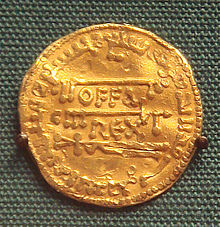Mancus
It is now generally accepted that mancus derives from the Arabic word منقوش manqūsh (from the triliteral verbal root n-q-sh 'to sculpt, engrave, inscribe'), which was often employed in a numismatic context to mean 'struck'.
Philip Grierson once linked it to the Latin adjective mancus, meaning 'defective', which was thought to be a reference to the poor quality of gold coinage circulating in 8th-century Italy.
[4] After its first appearance in the 770s, use of the term mancus quickly spread across northern and central Italy, and leapfrogged over Gaul to reach England by the 780s.
In many cases they had strong associations with specific issuing authorities such as a king (e.g., Coenwulf of Mercia),[6][7] emperor (like Louis the Pious) or archbishop (e.g., Wigmund of York).
In addition to these gold pieces with meaningful inscriptions issued in the west, there circulated some genuine Arabic dinars and imitations of them.

